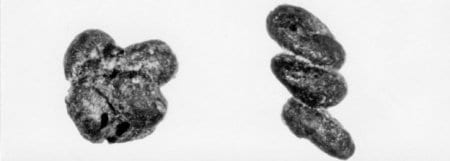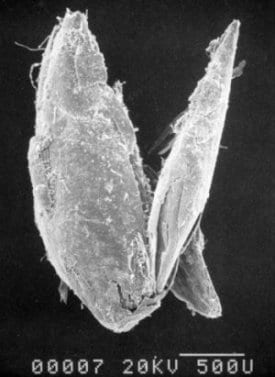Phalaris caroliniana Walter
Phalaris caroliniana Walter – Maygrass
Poaceae (Graminae)

Figure 1. Scanning electron micrograph of carbonized maygrass fruit from Oseola site. Mound B (02940 FS 12).
The fruits (caryopses) of Phalaris caroliniana have been identified from archaeological sites ranging from Alabama to southwestern Indiana and westward to Arkansas, Oklahoma, and Texas, whose dates of occupation span four millennia. Maygrass is a member of the eastern North American starchy seed complex whose domesticatory status is unknown.
Description
Caryopses are the most common part of maygrass plants recovered from archaeological sites. Mature fruits average between 1.8 and 2.3 mm in length and range from 0.9 to 1.8 mm in width (Cowan 1978; Radford et al. 1968:122). Experiments conducted by Asch and Asch (1985:190) indicate that maygrass fruits shrink an average of 10% after carbonization. Maygrass caryopses are ovoid-elongate and have basal-laterally located embryos. The embryo is often absent in charred fruits, resulting in a distinctive silhouette (Figure 1). Sometimes the sulcus, which runs along the hilum-bearing side, is observable on archaeological specimens (Figures 1 and 2).

Figure 2. Photograph of carbonized maygrass fruits from Oseola site, Mound B (02940 FS 12.

Figure 3. Photograph of carbonized clusters of maygrass seed from submound 51 at Cahokia, zone D2.
Charred caryopses, occurring singly (Figure 2) or in clumps (Figure 3), are commonly recovered from open air mesic sites. Rockshelters and caves have yielded uncarbonized maygrass fruits, inflorescences, and stems. Bound bundles of maygrass inflorescences have been recovered from a number of Eastern rockshelters (Cowan 1978). Uncharred fragments of maygrass florets are fairly common constituents of human paleofeces from Salts and Mammoth Cave, Kentucky (Yarnell 1974) (Figures 4 and 5).

Figure 4. Scanning electron micrograph of uncarbonized maygrass fruit, palea, and lemma from Salts Cave, specimen P60.
Archaeological Distribution
Maygrass first appears in the archaeological record of eastern North America during the Late Archaic Period. The Bacon Bend site (ca. 2400 B.C.), located in the Lower Tennessee River valley, provides some of the earliest maygrass known. Feature and midden samples from this short term camp site yielded 130 carbonized maygrass seeds (caryopses without pericarps) (Chapman and Shea 1981). Phalaris sp. caryopses which potentially date earlier have been recovered from Koster (6250 B.C.) and Campbell Hollow (5600 B. C.) sites in Illinois (Asch and Asch 1985). Four hundred and forty-four maygrass grains were identified from a late seventeenth century Native American village in the North Carolina piedmont (Gremillion 1987).

Figure 5. Scanning electron micrograph of uncarbonized maygrass lemma from Salts Cave, specimen P60.
Increased representation of Phalaris caroliniana at sites in Tennessee and Illinois during the Woodland period indicates that the taxon had become an important crop by this time. Maygrass is a major constituent of Early and Middle Woodland Period archaeobotanical assemblages in the Lower Tennessee Valley and it occurs to a lesser degree in Early Mississippian and Historic Period sites (Chapman and Shea 1981).
In the American Bottom, maygrass increases in importance along with other starchy seeds during Woodland times (Johannessen 1993). Maygrass continues to be an important component of ICT-II assemblages into the early Mississippian period when its occurrence, along with other starchy seeds, sharply decreases (Lopinot 1991:171). Asch and Asch (1985:188) report a “near absence” of maygrass grain from west-central Illinois sites earlier than Middle Woodland followed by an abundance of the taxon from later contexts.
The Modern Plant and Its Distribution
P. caroliniana is an erect annual which ranges from 0.2 to 1.2 m high and terminates in a panicle which can reach lengths of 9 cm or more (Radford et al. 1968). Natural populations of maygrass begin to flower in early April, and caryopses mature during May and June (Cowan 1978; Radford et al. 1968). Ripe fruit is reddish brown in color and tightly enclosed in its surrounding palea and lemma.
Maygrass is currently distributed throughout the southern half of North America and northern Mexico (Anderson 1961). In the United States, the taxon grows predominantly in the Southeast but does occur rarely in areas farther north. Although maygrass grows in a variety of habitats, it tends to favor disturbed environments (Cowan 1978).
Discussion
Human feces provide the most convincing evidence of prehistoric consumption of maygrass. Paleofecal samples from Mammoth and Salts Caves reveal maygrass to have been a common component of cavers’ diets during Early and Middle Woodland times (Yarnell 1974). Harvesting and nutritional studies demonstrate P. caroliniana to be an economically feasible and nutritious crop (Asch and Asch 1985; Crites and Terry 1984).
Despite the archaeological abundance and economic potential of maygrass, we have no unequivocal morphological evidence demonstrating that prehistoric maygrass populations underwent domestication or were subjected to intensive selection. Archaeological collections of maygrass fruits do not exhibit obvious morphological changes through time (Asch and Asch 1985; Cowan 1978; although see Johannessen (1981) for one instance of increased caryopsis size). Arguments for intentional propagation of maygrass by prehistoric people hinge upon the disjunction between the taxon’s archaeological and modern geographic ranges of occurrence (Cowan 1978).
Written by: Katherine M. Roberts
References
- Anderson D. E.
1961 Taxonomy and Distribution of the Genus Phalaris. Iowa State Journal of Science 36:1-36. - Asch, D. L., and N. B. Asch
1985 Prehistoric Plant Cultivation in West-Central Illinois. In Prehistoric Food Production in North America, edited by R. I. Ford, pp. 149-204. Anthropological Papers No. 75. Museum of Anthropology, University of Michigan, Ann Arbor. - Chapman, J., and A. B. Shea
1981 The Archaeobotanical Record: Early Archaic Period to Contact in the Lower Little Tennessee River Valley. Tennessee Anthropologist 6:61-84. - Crites, G. D., and R. D. Terry
1984 Nutritive Value of Maygrass. Economic Botany 38:114-120. - Cowan, C. W.
1978 The Prehistoric Use and Distribution of Maygrass in Eastern North America: Cultural and Phytogeographical Implications. In The Nature and Status of Ethnobotany, edited by R. I. Ford, pp. 263-288. Anthropological Papers, No. 67. Museum of Anthropology, University of Michigan, Ann Arbor. - Gremillion, K. J.
1987 Plant Remains from the Fredericks, Wall, and Mitchum Sites. In The Siouan Project: Seasons I and II, edited by R. S. Dickens, H. T. Ward, and R. P. S. Davis Jr., pp. 259-279. Monograph Series No. 1. Research Laboratories of Anthropology, University of North Carolina, Chapel Hill. - Johannessen, S.
1981 Plant Remains from the Julien Site (11-S-63). In The Julien Site (11-S-63):An Early Bluff and Mississippian Multicomponent Site, by G. R. Milner and J. A. Williams, pp. 197-214. FAI-270 Archaeological Mitigation Project Report 31. University of Illinois, Champaign-Urbana.
1993 Paleoethnobotany. In American Bottom Archaeology, edited by C. J. Bareis and J. W. Porter, pp. 197-214. University of Illinois Press, Urbana and Chicago. - Lopinot, N. H.
1991 Archaeobotanical Remains. In The Archaeology of the Cahokia Mounds ICT-II: Biological Remains, by N. H. Lopinot, L. S. Kelly, and G. R. Milner, pp. 1-189. Illinois Cultural Resources Study No.13. Illinois Historic Preservation Agency, Springfield. - Radford, A. E., H. E. Ahles, and C. R. Bell
1968 Manual of the Vascular Flora of the Carolinas. University of North Carolina Press, Chapel Hill. - Yarnell, R. A.
1974 Plant Food Cultivation of the Salts Cavers. In Archaeology of the Mammoth Cave Area, edited by P. J. Watson, pp. 113-122. Academic Press, New York.